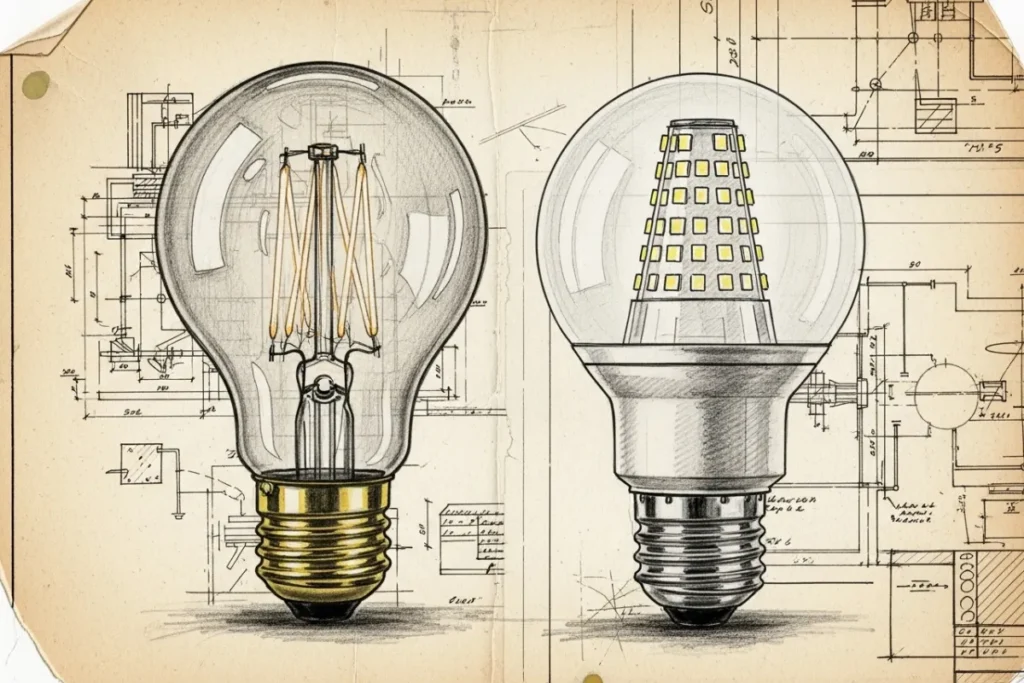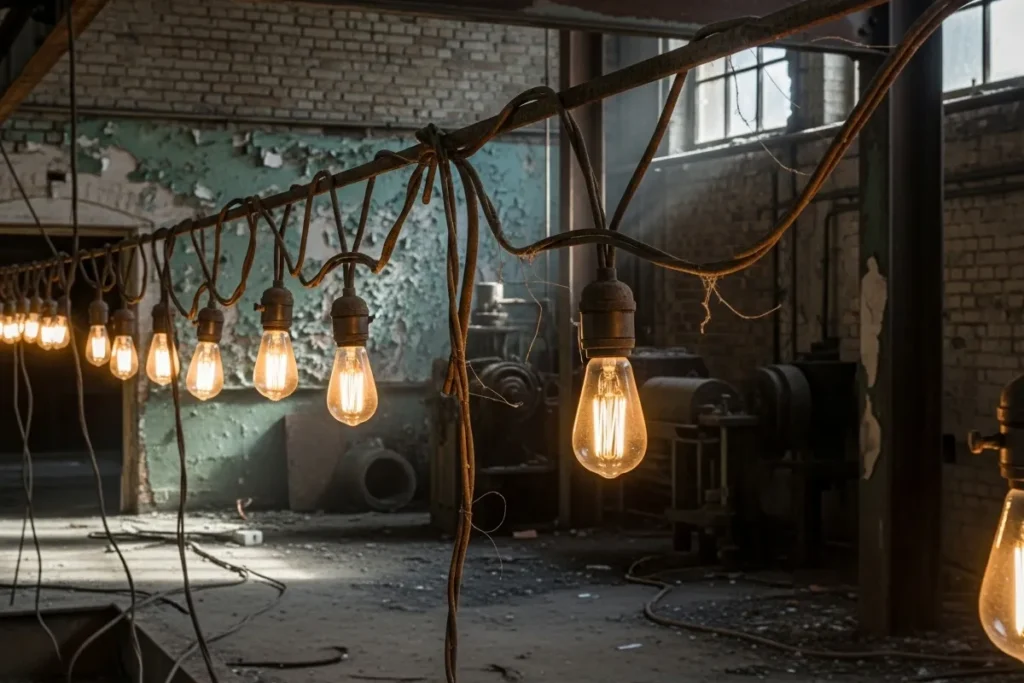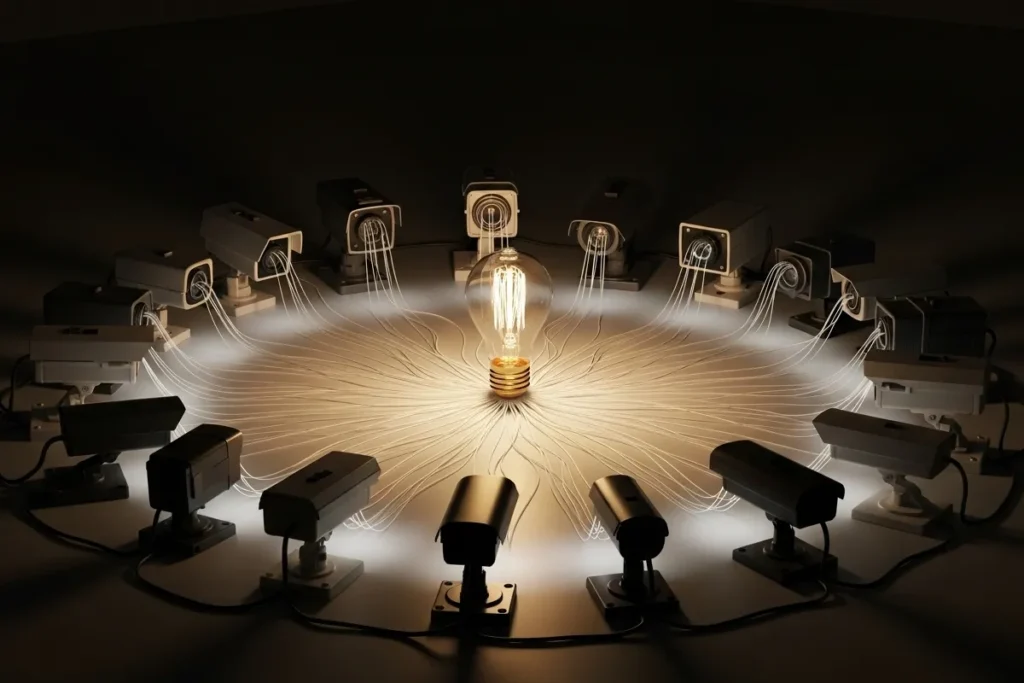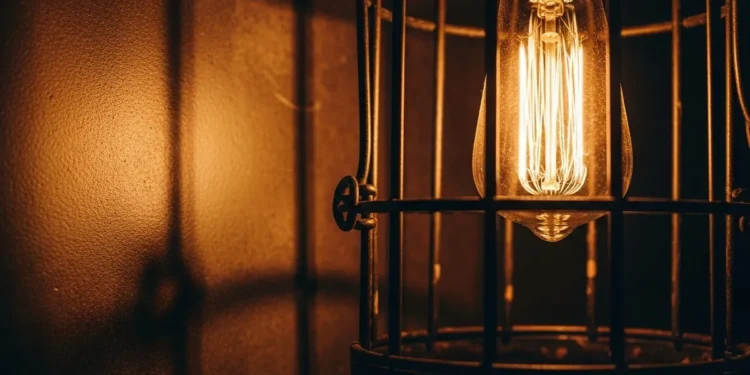Explore the fascinating history of electric lighting, from the invention of the lightbulb by Thomas Edison and Joseph Swan to its profound impact on urban life and societal structures. This blog post explores how electric light has transformed our daily routines, fueled nightlife, and sparked debates about surveillance and privacy. Examine the evolution from incandescent bulbs to modern LEDs, and reflect on the psychological effects of illumination on society. Understand how light, while enhancing safety and productivity, has also played a dual role in monitoring public spaces, raising important questions about the balance between security and civil liberties in contemporary life.
Table of Contents
The Birth of the History of the Lightbulb
The invention of the lightbulb marked a pivotal moment in the evolution of electric lighting, transforming not only how people illuminated their spaces but also reshaping societal structures. The journey to this groundbreaking innovation began in the early 19th century, against the backdrop of the Industrial Revolution —a time characterized by rapid technological advancements and significant social change. Among the most notable figures in this remarkable history are Thomas Edison, whose contributions to the development of a practical incandescent light source led to the commercialization of electric light, and Joseph Swan, who independently developed a similar technology in Britain, sparking a notable controversy over the invention’s credit.
Initial reactions to electric lighting were a mix of awe and skepticism. The concept of illuminating spaces using electric light was met with fascination as well as concern, as society grappled with the implications of such a significant departure from traditional gas lighting. While electric light promised increased safety and efficiency, it also raised questions about surveillance history through lighting and the implications of monitoring public spaces. The cultural impact of light extended beyond mere visibility; it redefined the roles of urban environments and the daily lives of individuals, creating new social dynamics.
As electric lighting systems began to proliferate, they catalyzed changes in both business practices and leisure activities, fostering a vibrant nightlife and altering societal routines. This revolutionary advancement illuminated streets and homes, influencing everything from architecture to labor patterns. Furthermore, the controversies surrounding the lightbulb’s inventors, including disputes over patent rights, underscored the competitive nature of technological innovation. Overall, the lightbulb symbolizes the intersection of ingenuity and societal evolution, highlighting how advancements can drive social transformation while also sparking debate and resistance.
The Evolution of the Lightbulb: From Incandescence to LED
The journey of the lightbulb, a quintessential element of modern illumination, is steeped in a rich history marked by continuous technological advancements. The evolution of electric lighting began with Thomas Edison’s incandescent bulb in the late 19th century, a breakthrough that allowed for a stable and long-lasting light source. This groundbreaking invention not only revolutionized the way people illuminated their homes and businesses but also catalyzed significant social change. With light now available after sunset, nightlife flourished, altering urban dynamics and enabling longer working hours.
However, the performance and efficiency limitations of incandescent bulbs led to the development of better alternatives. In the mid-20th century, the compact fluorescent light (CFL) emerged, offering improved energy efficiency and lifespan compared to its incandescent predecessor. During this period, society began to recognize the cultural impact of light as an essential component of daily life, enhancing productivity while also raising concerns about energy consumption and environmental sustainability.
The most significant milestone in the evolution of electric lighting came with the introduction of light-emitting diode (LED) technology in the early 21st century. LEDs are celebrated for their remarkable energy efficiency, longevity, and declining costs. This modern advancement showcases not just improvements in illumination but also serves as a reflection of wider technological and social shifts. The adoption of LEDs has influenced cultural patterns, transforming architectural designs, public spaces, and even art installations, providing a luminescent canvas that speaks to contemporary society’s embrace of innovation.
Reflecting on the surveillance history through lighting, the advancement of lightbulb technology also played a role in urban security measures. Cities can now illuminate vast areas, thereby fostering safer environments. Nonetheless, this potent tool carries ethical implications, drawing attention to the balance between safety and privacy in illuminated spaces. As we consider the evolution of the lightbulb, we discover its profound impact on urban landscapes, social interactions, and cultural identity.

Illumination and Urbanization: A New Era of Nightlife
The evolution of electric lighting marked a significant turning point in the development of urban environments. With the invention of the lightbulb, cities experienced a transformation wherein darkness was no longer a barrier to social interaction and commercial activities. This shift in illumination allowed for a radical extension of the hours in which people could engage in various pursuits, fundamentally altering the fabric of urban life.
Before the widespread adoption of electric lighting, cities largely succumbed to darkness at night. The absence of adequate lighting led to a decline in social gatherings and commerce, often restricting activities to daylight hours. However, the introduction of electric light transformed public spaces, enabling nightlife to thrive as a cultural phenomenon. Bars, theaters, and restaurants began to flourish after sunset, catering to a populace eager for leisure and entertainment. This shift not only fostered economic growth but also impacted social dynamics, as individuals congregated under the glow of electric lights, forming new relationships and communities.
The cultural impact of electric illumination extended beyond mere social interactions. It also served as a powerful tool for surveillance, altering the way urban spaces were monitored and controlled. The emergence of street lighting acted as a deterrent to crime, fostering a sense of security among citizens. This dual role of light in urban settings—both as a facilitator of nightlife and as a mechanism for control—demonstrates the complexity of its influence. Furthermore, the controversies surrounding the inventors of the lightbulb, such as Thomas Edison and Nikola Tesla, reveal a competitive spirit that also advanced the technical evolution of electric lighting.
As urban areas became more vibrant, the interplay between illumination and urbanization brought forth social change. Women, in particular, began to assert their presence in public spaces at night, challenging societal norms and expectations. Consequently, the evolution of electric lighting did not merely enhance visibility but acted as a catalyst for social transformations that continue to resonate today.
Light as a Tool of Surveillance: The Dark Side of Illumination
The introduction of the lightbulb marked a pivotal advancement in the evolution of electric lighting, with its implications reaching far beyond mere illumination. In urban environments, the presence of electric light transformed public spaces, facilitating a significant increase in surveillance opportunities. Illuminated streets and buildings became critical in fostering a sense of safety for citizens, yet simultaneously opened the door to heightened monitoring and control, establishing a complex relationship between comfort and oppression.
The brightening of the night was not without controversy; the lightbulb served as an instrument for authorities to scrutinize and oversee the movements of individuals. This dynamic laid the groundwork for what can be described as light-based surveillance throughout history, where the visibility afforded by electric light permitted an unprecedented level of oversight in urban areas. Citizens unwittingly became subjects of this heightened watchfulness, as the very infrastructure designed to provide safety inherently included dimensions of control.
This duality of light manifests in various forms, from streetlights illuminating public gatherings to the use of lighting in buildings that facilitated invisibility and vulnerability for those under scrutiny. The cultural impact of light, while often celebrated for its role in fostering progress, also reflects the darker applications of surveillance that accompanied its widespread adoption. Histories often overlook these nuances, revealing the inventor controversies surrounding the lightbulb, notably regarding the intentions behind its invention and deployment.
Considering the surveillance history through lighting not only helps us understand the past but also informs ongoing discussions regarding privacy and the implications of modern lighting in contemporary settings—a balance that continues to evolve. In conclusion, the legacy of the lightbulb goes beyond its immediate function, encapsulating a spectrum of societal control mechanisms that warrant critical examination.

The Psychological Impact of Electric Light on Society
The evolution of electric lighting has profoundly impacted human behavior and societal dynamics. As electric light became more accessible, it not only transformed physical spaces but also significantly influenced psychological well-being. Studies suggest that the presence of adequate lighting can enhance cognitive function and overall mood, while inadequate lighting can contribute to feelings of anxiety and vulnerability.
Throughout history, the introduction of lightbulbs has coincided with various changes in social structures and norms. For instance, the cultural impact of light can be seen in urban areas where well-lit streets foster a sense of safety and community. People tend to feel more secure in brightly illuminated environments, which can encourage social interactions and reduce crime rates. Conversely, dimly lit spaces are often associated with danger and apprehension, which can affect individuals’ willingness to engage with their surroundings and each other.
The relationship between light and mental health is further complicated by the advent of artificial lighting in the home and workplace. While light is essential for productivity, it can also create an oppressive atmosphere when used excessively. The psychological concept of “surveillance history through lighting” suggests that bright lights can amplify feelings of being watched or monitored, leading to increased stress and discomfort. This notion of social control through lighting demonstrates how the very technologies designed to enhance quality of life can inadvertently contribute to mental strain.
In addition, the controversies surrounding the inventors of the lightbulb often overshadow the multifaceted impacts of electric light on society. While the focus tends to be on technological advancements, the psychological implications are equally significant. As society continues to navigate the complexities of light and its various applications, understanding its effects on human behavior and social constructs remains essential. In conclusion, the interplay between electric light and human psychology exemplifies the dual-edged nature of technological progress, highlighting the need for a balanced approach to its implementation and usage.
Resistance and Activism: Light as a Symbol of Defiance
The history of electric lighting is not merely a narrative of inventions and advancements but also a chronicle of social change and resistance. Throughout history, individuals and movements have harnessed the power of light as a dynamic symbol of defiance against oppression. The evolution of electric lighting, particularly the lightbulb, has been pivotal in framing the contexts of numerous protests and demonstrations, effectively amplifying voices yearning for justice and equality.
One of the prominent examples is the use of light during the Civil Rights Movement in the United States. Activists, aiming to illuminate the injustices faced by African Americans, often organized rallies during nighttime, using torches and portable lights to confront the shadows of systemic inequalities. This approach not only emphasized their determination to fight against institutionalized racism but also served as a metaphor for hope and visibility in an otherwise dark landscape of oppression. The lightbulb became a beacon of empowerment, rallying communities to stand united in their struggle for civil liberties.
Moreover, the cultural impact of light extends globally, with various resistance movements adopting illumination as a tool for activism. For instance, the use of candles in peaceful protests symbolizes a steadfast commitment to non-violence and justice. In recent years, the phenomenon of “light art” has emerged in public demonstrations, where large installations of lights are employed to create immersive experiences that draw attention to social issues. Such artistic expressions transform public spaces into platforms for advocacy, effectively intertwining the aesthetic value of light with powerful messages of resistance.
The intriguing interplay between light and activism highlights the lightbulb’s role not just as a mere source of illumination but as a profound symbol of hope, visibility, and resilience against darkness. The unique relationship between lighting and social movements illustrates how electric lighting has evolved beyond its practical applications to become an emblem of defiance against oppressive forces.

The Duality of Progress: Evaluating Technology’s Role
The evolution of electric lighting, particularly the lightbulb, serves as a paradigm of technological advancement that has simultaneously propelled society forward while posing potential threats to civil liberties. Originally conceived as a means to enhance productivity and extend the utility of time beyond daylight hours, the lightbulb has profoundly impacted various aspects of contemporary life. Its introduction facilitated increased industrial activity, encouraged urbanization, and altered cultural practices related to work, leisure, and social interaction. The ability to illuminate spaces as previously unthinkable allowed for greater community engagement and transformed the nighttime landscape.
However, this very power to illuminate brings with it a darker side—contributing to surveillance history through lighting. Electric lighting systems, especially in urban areas, have been harnessed not just to ward off darkness but also to monitor public spaces and reinforce control. The implications extend beyond mere safety into the realm of privacy, as communities often find themselves under unobtrusive, watchful eyes, prompting debates surrounding the balance between security and individual rights. Surveillance technologies, complemented by advancements in lighting, raise crucial questions about the trade-offs inherent in our acceptance of innovation.
Moreover, controversies surrounding key inventors of the lightbulb highlight societal tensions between progress and ethics. Figures such as Thomas Edison and Nikola Tesla not only contributed extraordinary innovations but also engaged in fierce legal and commercial battles, raising ethical questions about ownership, credit, and influence. This backdrop invites critical reflection on the cultural impact of light, encouraging the acknowledgment that technology’s role is not unidimensional; it encapsulates the tension between advancement and regulation. The lightbulb, while a symbol of progress, also embodies the responsibility bestowed upon society to navigate the ethical pathways of innovation effectively.
Modern Reflections: The Continuing Legacy of Light
The evolution of electric lighting has significantly influenced contemporary society, especially in the realms of safety and surveillance. Modern technologies have introduced advanced streetlights equipped with surveillance cameras, transforming our urban landscapes. These innovations serve dual purposes: they illuminate public spaces and act as monitoring tools intended to enhance safety. However, they also raise pressing ethical concerns surrounding privacy and privacy rights.
As cities become increasingly aglow with artificial light, discussions about the social change triggered by such developments are more relevant than ever. The cultural impact of light today often involves a complex interplay between the assurance of security and the encroachment on personal freedoms. Citizens frequently find themselves navigating a world where illuminated environments can also mean constant monitoring. This surveillance history through lighting raises important questions: At what cost do we seek safety, and to what extent are we willing to trade privacy for security?
The controversies surrounding the inventor of the lightbulb, Thomas Edison, resonate within these discussions. Edison’s dominance in the electric lighting sector involved significant rivalries with other inventors, which has led to a broader understanding of innovation and its implications. These historical contexts provide insight into how contemporary issues such as the misuse of light for surveillance could evolve further, potentially threatening individual rights.
Additionally, the advent of smart lighting technologies promises both efficiency and further integration into surveillance systems, illustrating a sophisticated evolution of electric lighting. As we reflect on this legacy, it becomes essential to consider the conversations unfolding about the balance between light’s necessity for illuminating spaces and the implications that come with its association with surveillance. In this light, society continues to confront the footprint of its inventions, shaping future landscapes for generations to come.
| Topic | Key Points |
|---|---|
| Evolution of Electric Lighting | – Major shift in how public spaces are lit– From simple illumination to integrated technological systems |
| Modern Surveillance Streetlights | – Streetlights now often include built‑in cameras– Dual role: lighting + monitoring |
| Ethical & Privacy Concerns | – Raises questions about citizens’ rights– Tension between safety benefits and potential overreach |
| Social & Cultural Impact | – Urban landscapes reshaped by constant illumination– Citizens navigate enhanced security but reduced anonymity |
| Historical Controversies (Thomas Edison) | – Edison’s dominance sparked rivalries with other inventors– Offers historical perspective on innovation’s broader implications |
| Future & Smart Lighting Technologies | – Edison’s dominance sparked rivalries with other inventors– Offers a historical perspective on innovation’s broader implications |
Conclusion: Embracing the Light and Its Shadows
The evolution of electric lighting has undoubtedly revolutionized the way we live, marking a significant technological advancement since the introduction of the first light bulb. It has transformed daily life, extended productive hours beyond daylight, and enabled societies to flourish in heretofore unimaginable ways. However, as we delve deeper into the history of the lightbulb, we uncover layers that reveal its intertwined relationship with social change and various forms of surveillance (see the in‑depth analysis in The Architectural Review). From the initial inventor controversies surrounding the lightbulb to the modern usage of lighting in surveillance, the implications of our reliance on electric light extend beyond mere convenience.
The cultural impact of light through history illustrates how illumination not only serves functional purposes but has also been a tool for control and social division. The advent of lighting has frequently been tied to broader societal issues, from its role in enhancing productivity during industrialization to its use in maintaining order through surveillance. The light offers clarity in a metaphorical sense, but it can also cast shadows where the consequences of its use may be less benign. By recognizing this duality, we can better understand the full implications of lighting in our modern environments.








